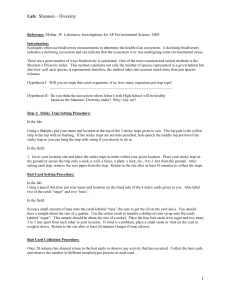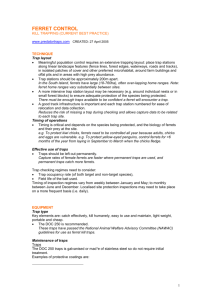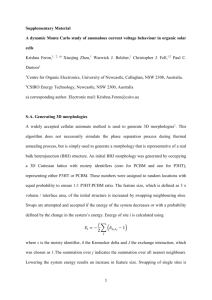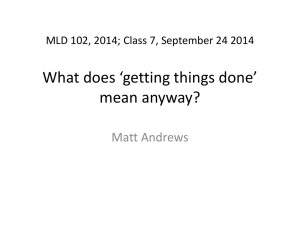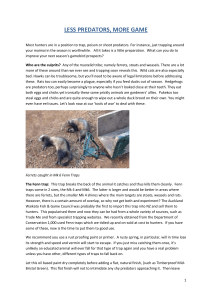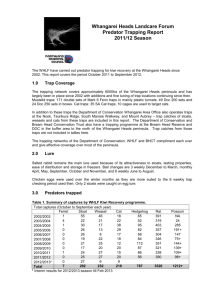Booby Traps - missmcdonnellshistoryclass
advertisement
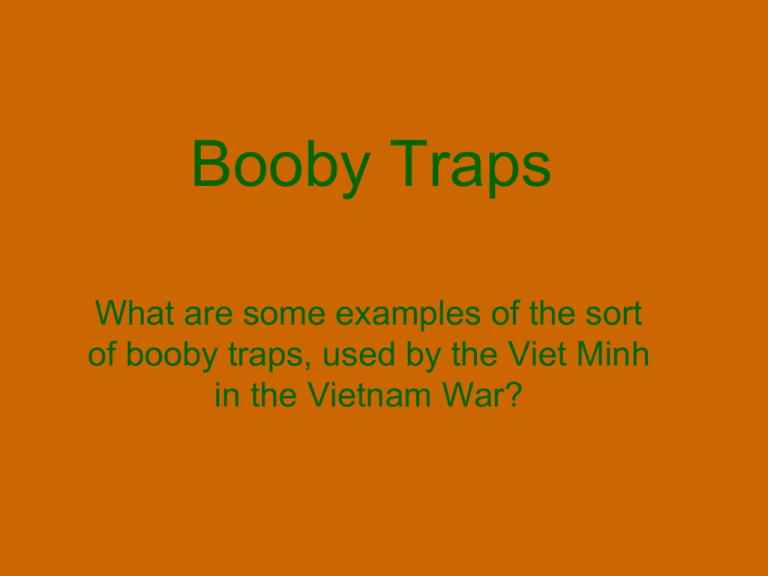
Booby Traps What are some examples of the sort of booby traps, used by the Viet Minh in the Vietnam War? What is a Booby Trap? • Used in warfare to kill or seriously injure • Generally consist of a trip wire • Usually triggered unknowingly by the victim • Hidden from eyesight • Easy to conceal and simple to set up In the War in Vietnam, the Viet Minh’s use of booby traps proved very useful in their campaign against the Allied forces. Many underestimated the Viet Minh during the war however their ability to create intelligent booby traps showed the world how innovative they could be. Their use of booby traps was more so used in the war to injure, rather than kill invading soldiers. This was because they believed it took more people out of the war effort to look after an injured soldier, rather than just taking out the one. Grenade Traps Grenade Trap in River Bed • Hidden beneath the surface of shallow rivers or creek beds • Involving trip wire • Blast radius – 10-20m Grenade Trap in Jungle • • • • • Similar to grenade trap in river bed Safety pins completely removed US’s litter cans Trip wire used Explosions from both sides • Blast radius – 10-20m Many soldiers lost limbs as a result of grenade explosions. They also experiences large wounds and death. Traps Suspended in the Jungle Trees Above Mace Trap • Takes out a large number of soldiers in one hit. • Concrete ball, drum, box or large log – spikes hammered in to outside. • Suspended in threes above and concealed. • Triggered by trip wire. • Harsh wounds and broken bones sustained Spike Traps Side-Closing Panji Trap (1) (There are two versions of a side-closing Panji trap) • One of the most commonly used booby traps. • Dug into the ground so victims fall into it. • Covered in leaves and sticks to hide from eyesight. • Wounds to feet and ankles Side-Closing Panji Trap (2) • Bear trap instead of spike board. • Two holes, one below the other. • Bear trap would close in around foot and ankle, then be pushed further into the skin by the second hole. Side-Closing Trap • • • • • Two spiked wooden slats. Large hole below. Trap held together by large rubber bands. Concealed by leaves and sticks. Rubber bands trigger trap to close in on victims body. The Spike Board • Trigger – treadle board (is stepped on) • Spike board causes the injury. • Concealed by sticks and leaves. • Strikes victim in the face or chest. The majority of spikes on spike traps were covered in animal faeces. This would further harm the soldiers as harsh bacteria would get directly into their wounds. Many soldiers were taken out of the war effort because of these infections, e.g. gangrene. Trap Markers Guerrilla Tactics When the enemy advances - we retreat. Able to still attack once retreated. When the enemy halts – harass. Psychologically harassing Allied soldiers through the fear of hidden booby traps. When the enemy avoids battle – we attack. Could still attack when Allied soldiers retreated. When the enemy retreats – we follow. Allowed for continuous attacks and more likelihood of Allied casualties. Alternative uses for trap – animal hunting Traps used in Vietnam War – derivative of hunting traps. • Perch Spear Trap (similar to spike traps used) - Spikes attached to sticks held together with string. - When trip wire is triggered, spikes fly up and wound the animal, killing it. Thankyou. (: SACE Stage 1 Modern History Types of Warfare used in the Vietnam War Nicole Halsey 11R 2011

